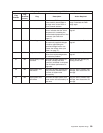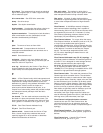
Glossary
This glossary defines the special terms,
abbreviations, and acronyms that are used in this
publication.
Numbers and Symbols
2:1 compression. The relationship between the
quantity of data that can be stored with compression as
compared to the quantity of data that can be stored
without compression. In 2:1 compression, twice as
much data can be stored with compression as can be
stored without compression.
µs. Abbreviation for microsecond or one millionth of a
second (.000001 s).
A
A. See ampere.
acclimation time. Pertaining to the Ultrium 2 Tape
Drive, the amount of time that is needed for the drive to
adjust to change in temperature, altitude, climate, or
environment.
active. The condition that the SCSI bus is in when a
server is trying to use one or more devices on the bus.
adapter. See adapter card.
adapter card. A circuit board that adds function to a
computer.
AL_PA. See Arbitrated Loop Physical Address.
amp. See ampere.
ampere (A, amp). A unit of measure for electric
current that is equivalent to a flow of one coulomb per
second, or equivalent to the current produced by one
volt applied across a resistance of one ohm.
American National Standards Institute. A private,
non-profit organization that gathers and disseminates
information about standards and conformity issues that
affect the business, government, and people of the
United States.
ANSI. See American National Standards Institute.
Arbitrated Loop Physical Address (AL_PA). An 8-bit
value that identifies a device in an arbitrated loop. All
Fibre Channel ports communicate by using AL_PAs.
autosense data. Sent by the drive to the server,
sense data that automatically accompanies a Check
Condition in response to an error. The server does not
need to send a REQUEST SENSE command to get the
sense data. Autosense data is available only in the
Fibre Channel version of the Ultrium 2 Tape Drive
(Model T400F).
B
backhitch. During tape movement (reading or writing),
the condition that occurs when the tape drive must stop
the tape, reverse it, and restart tape motion due to
certain events. A backhitch usually occurs when the
server’s net (compressed) data rate is less than the
drive’s data rate.
backreflection. Pertaining to instances where light is
launched into an optical fiber in a forward direction, the
light that is returned to the launch point in the reverse
direction.
backups. The short-term retention of records used for
restoring essential business and server files when vital
data has been lost because of program or server errors
or malfunctions.
backward compatible. Capable of being used with a
previous product that was designed for a similar
purpose. For example, a tape cartridge that is designed
to be used with a modern tape drive but can also be
used with certain older tape drives. Synonymous with
downward compatible.
bar code. A code that represents characters by sets of
parallel bars of varying thickness and separation. The
bars are read optically by transverse scanning.
bar code label. A slip of paper bearing a bar code and
having an adhesive backing. The bar code label must
be affixed to a tape cartridge to enable the library to
identify the cartridge and its volume serial number.
bezel. The removable frame that fits over the front of
the Ultrium 2 Tape Drive.
bit. The smallest unit of data in a computer. A bit
(short for binary digit) has a single binary value (either 0
or 1). Computers store data and execute instructions in
bit multiples called bytes. In most computer systems,
there are eight bits in a byte.
burst data transfer rate. The maximum speed at
which data is transferred.
bus. See SCSI bus.
byte. A string that consists of a certain number of bits
(usually 8) which are treated as a unit and represent a
character. A byte is a fundamental unit of data.
© Copyright IBM Corp. 2002 105


















